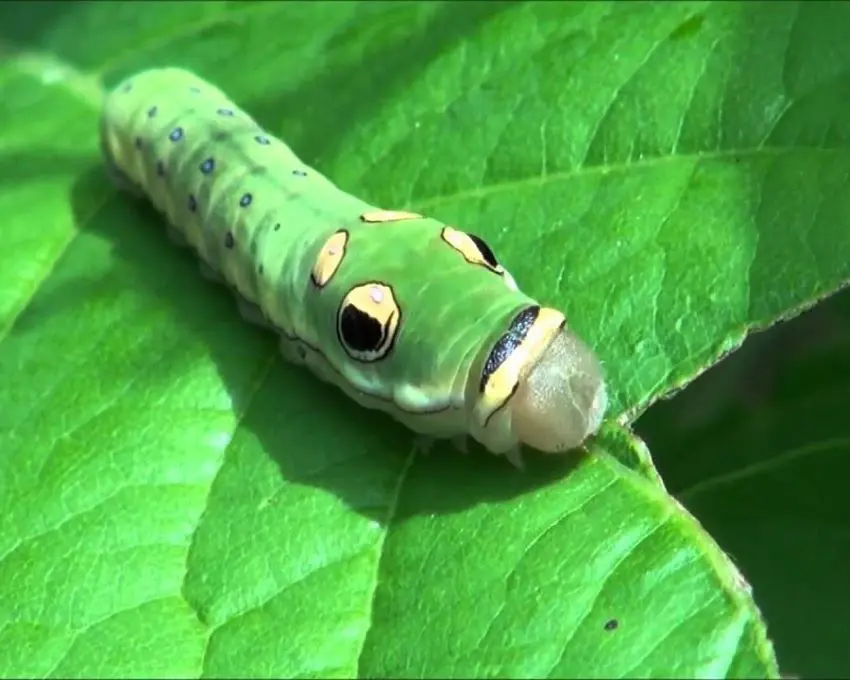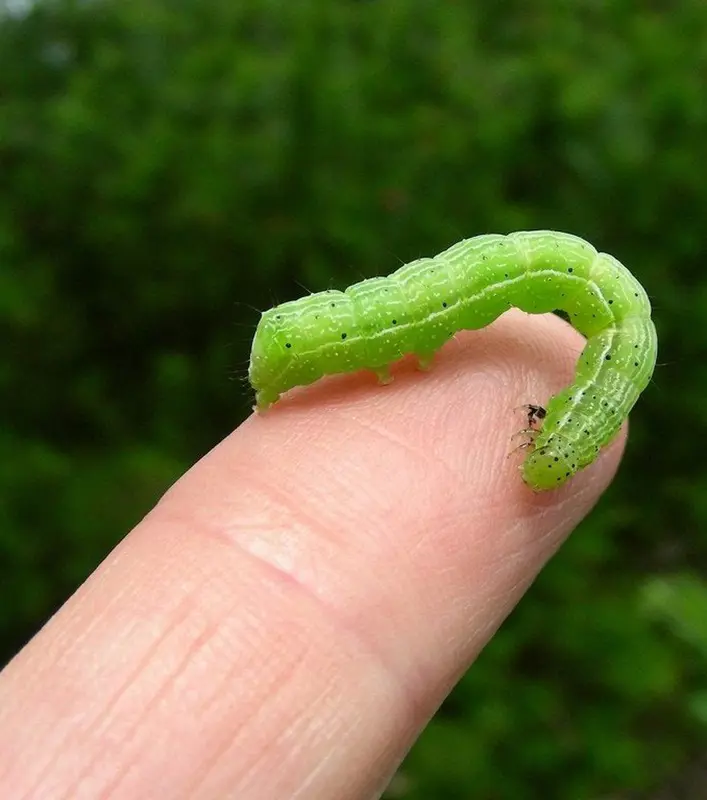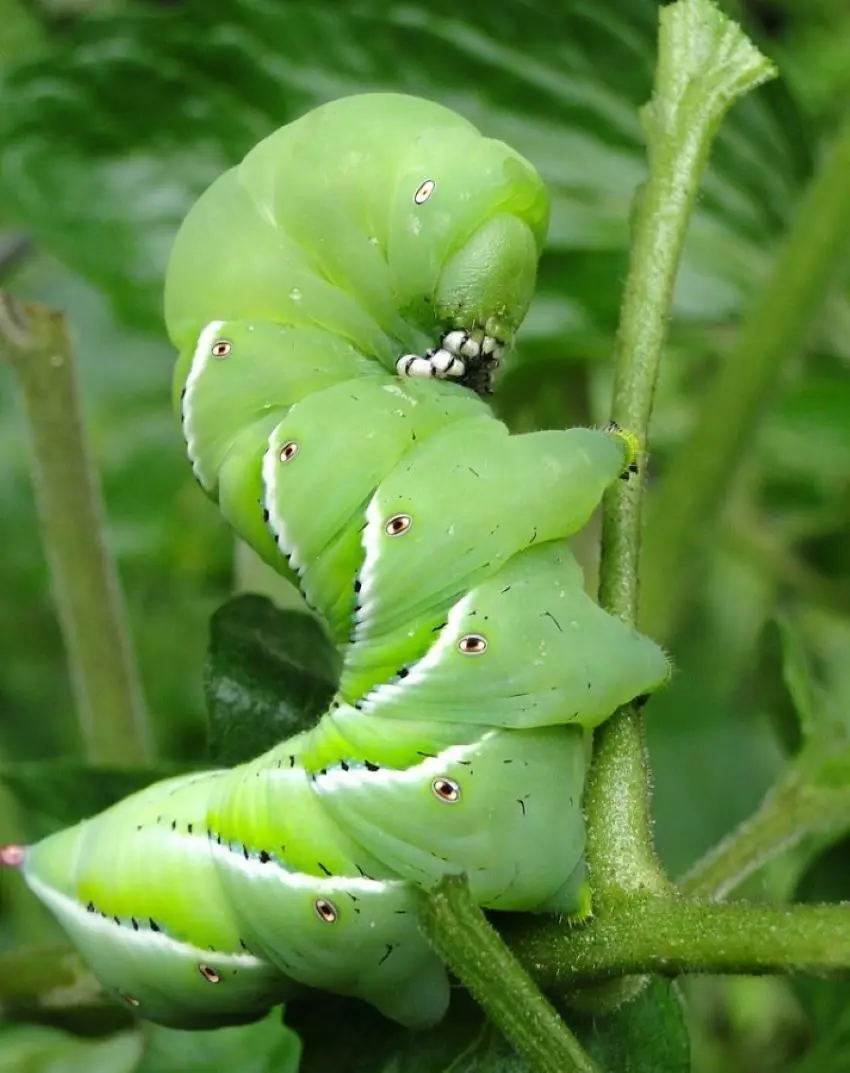Caterpillars, the larval stage of butterflies and moths, are a diverse and fascinating group within the insect world.
Their green coloration serves as effective camouflage in various habitats, ranging from forests to gardens, and they play crucial roles in ecosystems as herbivores, prey, and pollinators.
This comprehensive guide provides detailed insights into 18 common types of green caterpillars, covering their scientific names, transformations into adult forms, habitats, and ecological significance.
1. Io Moth Caterpillar (Automeris io)
- Scientific Name: Automeris io
- Turns into: Io Moth
- Found in: North America
The Io Moth Caterpillar is easily recognizable by its vibrant green body adorned with red and white lateral stripes and clusters of venomous spines. These caterpillars are commonly found in deciduous forests, parks, and gardens throughout North America.
They feed on a variety of plants including corn, roses, and willow. Upon completing metamorphosis, they emerge as the Io Moth (Automeris io), known for its striking eyespots on the hindwings that serve as a defense mechanism against predators.
2. Luna Moth Caterpillar (Actias luna)
- Scientific Name: Actias luna
- Turns into: Luna Moth
- Found in: Eastern United States and Canada
The Luna Moth Caterpillar features a lime green body with prominent yellow lines and small red spots. It primarily inhabits walnut, hickory, and sumac trees in the eastern regions of the United States and Canada.
Upon reaching maturity, it transforms into the Luna Moth, renowned for its pale green wings and long, sweeping tails. This species is nocturnal and is often attracted to lights during its brief adult lifespan.
3. Polyphemus Moth Caterpillar (Antheraea polyphemus)
- Scientific Name: Antheraea polyphemus
- Turns into: Polyphemus Moth
- Found in: North America
Polyphemus Moth Caterpillars have a robust green body with yellow stripes and red tubercles. They are commonly found in deciduous forests across North America, feeding on leaves of oak, maple, and birch trees.
The adult Polyphemus Moth is one of the largest moth species in North America, characterized by its impressive wingspan and distinctive eye-like patterns on the forewings, which resemble the mythical Cyclops Polyphemus.
4. Cecropia Moth Caterpillar (Hyalophora cecropia)
- Scientific Name: Hyalophora cecropia
- Turns into: Cecropia Moth
- Found in: North America
Cecropia Moth Caterpillars are striking with their green bodies adorned with blue, yellow, and orange tubercles. They prefer maple, cherry, and apple trees found in North American woodlands.
Upon metamorphosis, they emerge as the Cecropia Moth, notable for its large size and wings decorated with intricate patterns of red, white, and black. This species is often seen during late spring and early summer, attracted to lights at night.
5. Spicebush Swallowtail Caterpillar (Papilio troilus)

- Scientific Name: Papilio troilus
- Turns into: Spicebush Swallowtail Butterfly
- Found in: Eastern United States
The Spicebush Swallowtail Caterpillar displays a green body with large false eyespots near its head, resembling a snake to deter predators. It primarily inhabits spicebush and sassafras trees across the eastern United States.
Upon completing its life cycle, it transforms into the Spicebush Swallowtail Butterfly, known for its elegant flight and striking blue hindwings. This species plays a significant role as a pollinator in its native habitat.
6. Eastern Tiger Swallowtail Caterpillar (Papilio glaucus)
- Scientific Name: Papilio glaucus
- Turns into: Eastern Tiger Swallowtail Butterfly
- Found in: Eastern United States
Eastern Tiger Swallowtail Caterpillars are recognized by their green bodies adorned with false eyespots, which resemble larger animals to ward off predators. They are commonly found on cherry, ash, and tulip trees throughout the eastern United States.
Upon metamorphosis, they transform into the iconic Eastern Tiger Swallowtail Butterfly, distinguished by its vibrant yellow and black striped wings. This butterfly is a familiar sight in gardens and wooded areas during the summer months.
7. Tomato Hornworm (Manduca quinquemaculata)
- Scientific Name: Manduca quinquemaculata
- Turns into: Five-Spotted Hawk Moth
- Found in: North America
The Tomato Hornworm is a robust green caterpillar with distinctive white diagonal stripes and a prominent black horn at its posterior. It is notorious for feeding on tomato plants and other members of the nightshade family across North America.
Upon completing metamorphosis, it emerges as the Five-Spotted Hawk Moth, characterized by its large size and intricate wing patterns. This species is attracted to flowers such as petunias and moonflowers during its adult stage.
8. Tobacco Hornworm (Manduca sexta)
- Scientific Name: Manduca sexta
- Turns into: Carolina Sphinx Moth
- Found in: North and South America
The Tobacco Hornworm features a green body with diagonal white stripes and a red horn at its rear. It primarily feeds on tobacco, tomato, and pepper plants in both North and South America.
Upon reaching adulthood, it transforms into the Carolina Sphinx Moth, which is known for its robust body and mottled brown wings. This moth species is attracted to garden flowers such as petunias and phlox for nectar.
9. White-Lined Sphinx Moth Caterpillar (Hyles lineata)
- Scientific Name: Hyles lineata
- Turns into: White-Lined Sphinx Moth
- Found in: North and Central America
White-Lined Sphinx Moth Caterpillars vary in coloration but are typically green with black and white markings. They feed on a variety of plants including evening primrose and purslane throughout their range in North and Central America.
The adult White-Lined Sphinx Moth is distinguished by its rapid flight and wings adorned with prominent white lines. This species is known for its ability to hover over flowers while feeding on nectar.
10. Copper Underwing Caterpillar (Amphipyra pyramidea)
- Scientific Name: Amphipyra pyramidea
- Turns into: Copper Underwing Moth
- Found in: Europe and North America
Copper Underwing Caterpillars have a bright green body with a striking yellow lateral stripe. They primarily feed on oak, maple, and apple trees across Europe and North America.
Upon completing metamorphosis, they emerge as the Copper Underwing Moth, characterized by its coppery-colored hindwings with prominent black markings. This moth species is nocturnal and is attracted to light sources during its adult stage.
11. Cloudless Sulphur Caterpillar (Phoebis sennae)
- Scientific Name: Phoebis sennae
- Turns into: Cloudless Sulphur Butterfly
- Found in: Southern United States, Central, and South America
Cloudless Sulphur Caterpillars have a green body with prominent yellow lateral lines and small black spots. They exclusively feed on cassia plants and other pea family members throughout their habitat in the southern United States, Central, and South America.
Upon reaching maturity, they transform into the Cloudless Sulphur Butterfly, known for its bright yellow wings. This butterfly species is migratory and can be found in open fields and gardens.
12. Cabbage Looper Caterpillar (Trichoplusia ni)

- Scientific Name: Trichoplusia ni
- Turns into: Cabbage Looper Moth
- Found in: Worldwide
Cabbage Looper Caterpillars are characterized by their pale green bodies adorned with white stripes along the sides. They are notorious pests of cabbage, kale, and other cruciferous vegetables worldwide.
Upon completing metamorphosis, they emerge as the Cabbage Looper Moth, featuring mottled brown wings with a silver crescent-shaped mark. This moth species is nocturnal and is attracted to garden lights and flowering plants for nectar.
13. Cross-Striped Cabbageworm (Evergestis rimosalis)
- Scientific Name: Evergestis rimosalis
- Turns into: Cross-Striped Cabbage Moth
- Found in: Eastern United States
Cross-Striped Cabbageworms have a green body with distinct dark stripes crossing horizontally. They primarily feed on cabbage, broccoli, and related plants throughout the eastern United States.
Upon completing their life cycle, they transform into the Cross-Striped Cabbage Moth, characterized by its gray and brown wings with a distinct pattern. This moth species is nocturnal and is commonly found in agricultural fields and gardens.
14. Green Cloverworm (Hypena scabra)
- Scientific Name: Hypena scabra
- Turns into: Green Cloverworm Moth
- Found in: North America
Green Cloverworms have a pale green body with three prominent white lines along the dorsal surface. They primarily feed on soybeans, clover, and other leguminous plants across North America. Upon completing metamorphosis, they emerge as the Green Cloverworm Moth, characterized by its small size and brown coloration with fringed edges on the wings. This moth species is nocturnal and is often attracted to lights during its adult stage.
15. Large Yellow Underwing Caterpillar (Noctua pronuba)
- Scientific Name: Noctua pronuba
- Turns into: Large Yellow Underwing Moth
- Found in: Europe and North America
Large Yellow Underwing Caterpillars have a green body with subtle yellow stripes, feeding primarily on grasses and various garden plants across Europe and North America.
Upon completing metamorphosis, they transform into the Large Yellow Underwing Moth, known for its vibrant yellow hindwings that contrast with its mottled brown forewings. This moth species is nocturnal and is attracted to garden flowers for nectar.
16. European Skipper Caterpillar (Thymelicus lineola)
- Scientific Name: Thymelicus lineola
- Turns into: European Skipper Butterfly
- Found in: Europe and North America
European Skipper Caterpillars have green bodies adorned with white dorsal and lateral lines. They primarily feed on grasses in habitats spanning Europe and North America.
Upon completing metamorphosis, they emerge as the European Skipper Butterfly, featuring a small yet vibrant orange body and fluttering flight. This butterfly species is commonly found in meadows and grasslands during the summer months.
17. American Lady Caterpillar (Vanessa virginiensis)
- Scientific Name: Vanessa virginiensis
- Turns into: American Lady Butterfly
- Found in: North America
American Lady Caterpillars have green bodies covered in spiny projections and yellow lateral stripes. They feed on cudweed and pearly everlasting plants found across North America.
Upon reaching maturity, they transform into the American Lady Butterfly, known for its distinctive orange and black patterns on its wings and prominent eyespots. This butterfly species is migratory and is often seen in open fields and gardens.
18. Anise Swallowtail Caterpillar (Papilio zelicaon)

- Scientific Name: Papilio zelicaon
- Turns into: Anise Swallowtail Butterfly
- Found in: Western United States
Anise Swallowtail Caterpillars have green bodies with black bands and yellow spots. They exclusively feed on plants in the carrot family, including fennel and parsley, throughout the western United States.
Upon reaching maturity, they transform into the Anise Swallowtail Butterfly, featuring beautiful yellow wings with black stripes. This butterfly species is common in gardens and open habitats, where it pollinates a variety of flowers.
Importance of Green Caterpillars
Green caterpillars play vital roles in ecosystems as both consumers of vegetation and prey for other organisms. Their feeding habits often influence plant diversity and population dynamics within habitats.
Many caterpillar species have evolved specialized adaptations, such as mimicry and camouflage, to evade predators and increase their survival rates during vulnerable developmental stages.
Furthermore, caterpillars serve as crucial links in food webs, providing essential nutrients for predators and contributing to nutrient cycling through their frass (excrement).
Their interactions with plants can also influence plant health and distribution, making them integral components of biodiversity conservation efforts.
Conservation Considerations
Conserving caterpillar diversity is essential for maintaining healthy ecosystems and supporting pollinator populations.
Many butterfly and moth species are indicators of habitat quality, and declines in their populations can signal broader environmental concerns, including habitat loss, climate change, and pesticide use.
Efforts to protect caterpillars often involve preserving their host plants and habitats, implementing sustainable agricultural practices, and raising awareness about their ecological roles.
Citizen science initiatives, such as butterfly and moth monitoring programs, contribute valuable data to conservation efforts by tracking population trends and distribution patterns.







